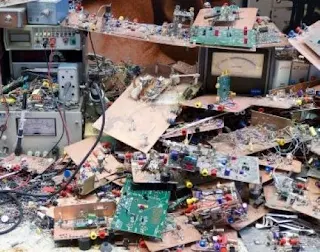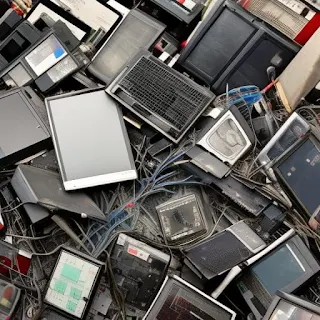From Gadgets to Garbage: Electronic Waste Problems and the Throwaway Culture
E-waste issues in Africa stem from a culture of disposability, lucrative global trade in e-waste, irresponsible donation of electronics, and cost of proper disposal.
From Gadgets to Garbage: Electronic Waste Problems and the Throwaway Culture.The increasing use of electronic devices, combined with a culture of convenience and disposability, has contributed to the rapid accumulation of electronic waste and a significant environmental and health problem in Africa.
The e-waste problem in Africa is closely related to our throwaway culture.
A throwaway culture refers to a society or a lifestyle that prioritizes convenience and disposability over sustainability and durability. Many electronic products, known as e-waste products are designed to have a short lifespan, leading to a significant amount of e-waste and environmental degradation. As the use of electronic devices continues to increase in Africa, so does the amount of electronic waste. Many electronic devices have a short lifespan and are not designed for repair, leading to an increase in electronic waste that is often improperly disposed of leads to environmental and health problems.
 |
| e-waste problem in Africa |
The e-waste problem is closely related to the throwaway culture, where many products, including electronic devices, are designed to be used for a limited time and then discarded, rather than being repaired or recycled. This throwaway culture encourages the production of more electronic devices, and the rapid replacement of older ones, leading to a constant stream of electronic waste.
The throwaway culture also contributes to the e-waste problem by making it more challenging to repair or recycle electronic devices. Many electronic devices are designed to be difficult or impossible to repair, with manufacturers using proprietary parts and making it challenging to access repair manuals. As a result, many electronic devices are discarded rather than repaired, contributing to the accumulation of e-waste.
Also, the throwaway culture also affects consumer behavior, leading to the disposal of functional electronic devices that are still usable. Consumers may dispose of functional electronic devices because they are no longer fashionable or because they want to upgrade to the latest model, contributing to the accumulation of e-waste.
The throwaway culture is a significant driver of the e-waste problem, contributing to the rapid accumulation of electronic waste and making it more challenging to manage and dispose of this waste in an environmentally sustainable way. Addressing the throwaway culture is essential to mitigate the e-waste problem and to promote sustainable development.
The global trade in e-waste and Africa.
Some estimates suggest that the global trade in e-waste is worth billions of dollars annually. According to a report by the United Nations University, the value of raw materials in e-waste is estimated to be around $62.5 billion annually. The global trade in e-waste refers to the movement of electronic waste from developed countries to developing countries, often in Africa and Asia, where it is often processed through informal and often unsafe methods. This trade can contribute to the growing e-waste problem in developing countries, including Africa.
Developed countries often export e-waste to developing countries because of cheaper labor costs and looser environmental regulations, making it more profitable to process and dispose of e-waste in these countries. However, this often leads to unsafe and informal recycling methods, which can expose workers and local communities to toxic substances and pollutants.
Many developing countries, including those in Africa, lack the infrastructure and resources to properly manage e-waste, leading to the disposal of e-waste in landfills or incineration, which can harm the environment and human health. The importation of e-waste also displaces local e-waste management businesses, which can hinder local economic development.
Furthermore, some developed countries often disguise e-waste as used or second-hand goods, in violation of international regulations, making it difficult to track and regulate the movement of e-waste. The global trade in e-waste is a significant problem that contributes to the growing e-waste problem in developing countries, including Africa. It highlights the need for increased regulation and investment in e-waste management, as well as responsible disposal practices in developed countries.
The international regulations for the movement of e-waste are designed to prevent the illegal dumping and trade of hazardous waste between countries, as well as to promote responsible management and disposal of electronic waste. The two key international agreements that regulate the movement of e-waste are the Basel Convention on the Control of Transboundary Movements of Hazardous Wastes and Their Disposal and the Stockholm Convention on Persistent Organic Pollutants (POPs).
The Basel Convention, which came into force in 1992, is a global treaty that aims to control the transboundary movement of hazardous waste, including e-waste, and to promote its environmentally sound management. The convention prohibits the export of hazardous waste from developed to developing countries, except in cases where it is for environmentally sound disposal or recycling.
The Stockholm Convention, which came into force in 2004, aims to eliminate or restrict the production, use, and release of persistent organic pollutants, including those found in e-waste. The convention seeks to minimize the generation of POPs in e-waste and to promote safe and sustainable alternatives to their use. In addition to these international agreements, many countries have their own laws and regulations for the management and disposal of electronic waste, which can vary widely in scope and effectiveness.
The e-waste problem in Africa and how it is affecting local communities.
Agbogbloshie in Ghana is one of the largest e-waste dumping sites in the world, where thousands of tons of e-waste from Europe, North America, and Asia are dumped each year. The local community has to deal with toxic fumes from burning e-waste, which causes respiratory and other health problems.
According to a report by the Basel Convention, Nigeria is the largest importer of used electronics in Africa. Much of the e-waste is not properly disposed of, and instead, it is burned in open pits or dumped in landfills. This causes toxic chemicals to leach into the soil and water, which can harm local communities' health.
In Nairobi, the Dandora dumpsite is the largest dumping ground for e-waste in Kenya. The dumpsite is located in a residential area, and the local community is exposed to hazardous chemicals from the e-waste, which can cause health problems such as respiratory illnesses and skin irritation.
The city of Abidjan is another example of how e-waste affects local communities. The city is home to one of the largest e-waste dumping sites in West Africa, where toxic chemicals from e-waste are contaminating the water supply and soil, leading to health problems for local communities.
 |
| e-waste problem in Africa |
E-waste problems in Africa short term and long term effects.
The e-waste problem has significant short-term and long-term consequences for the environment and human health.
In the short term, improper management and disposal of e-waste can result in immediate environmental and health impacts. E-waste often contains hazardous substances such as lead, mercury, and cadmium, which can leach into soil and water sources, contaminating local ecosystems and posing a risk to human health. The informal and often unsafe methods of e-waste recycling used in some developing countries can expose workers and local communities to toxic substances and pollutants, leading to immediate health effects such as respiratory and skin problems.
In the long term, the accumulation of e-waste has even more severe environmental and health impacts. E-waste can take hundreds of years to decompose, and if it is not properly managed, it can accumulate in landfills and cause pollution over an extended period. The leaching of toxic substances into the environment can cause long-term environmental degradation, including soil and water contamination, and harm to ecosystems and wildlife.
Moreover, the long-term health effects of exposure to hazardous substances found in e-waste can be severe and can manifest over time. For example, exposure to lead can lead to developmental and neurological disorders, while exposure to cadmium can lead to kidney disease.
The e-waste problem has significant short-term and long-term consequences for the environment and human health. Proper management and disposal of e-waste are essential to mitigate these impacts and to promote sustainable development.
Electronic devices designed for temporary use and not designed for repair are donated to Africa.
There are many electronic devices that are designed for temporary use and not intended for repair such as smartphones and tablets,laptops and computers and printers. Smartphones and tablets are often designed to be sleek and lightweight, with a focus on the latest technology and features. However, this often comes at the expense of durability and repairability, with many components being difficult or impossible to replace.
Laptops and computers, similar to smartphones and tablets, laptops and computers are often designed for fast obsolescence, with new models and updates released frequently. Many components of these devices are also difficult to replace, making repair less feasible. Many printers are designed to be disposable, with cheap models flooding the market and more expensive models often requiring proprietary ink cartridges that are expensive to replace. This can make repair more expensive than buying a new printer.
Africa is experiencing piles of electronic waste, what is happening to this electronic waste.
Africa is experiencing a growing pile of electronic waste due to a variety of factors. One major factor is the increasing amount of electronic devices being used in Africa, as technology becomes more accessible and affordable. However, many of these devices have a short lifespan and are not designed for repair, which leads to a rapid increase in electronic waste.
Also, many developed countries are exporting their electronic waste to African countries, often in violation of international laws and regulations. This e-waste may be disguised as donations or sold to African countries as cheap raw materials, contributing to the growing pile of electronic waste in Africa.
Once electronic waste is discarded, it can have serious environmental and health consequences. E-waste often contains hazardous materials such as lead, cadmium, and mercury, which can pollute the soil, air, and water. These toxic materials can harm the health of workers who handle the e-waste without proper safety equipment and pose long-term health risks to nearby communities.
Furthermore, when e-waste is not properly disposed of, it can release harmful chemicals into the environment, contaminating groundwater and soil, and leading to health problems for people and wildlife. Overall, the growing pile of electronic waste in Africa highlights the need for improved waste management practices and a shift towards a more sustainable, circular economy.
The donation of smartphones, laptops and computers and printers from other nations is causing electronic waste problems in Africa.
The donation of smartphones, laptops, and computers from first world nations to African countries can contribute to electronic waste problems if the devices are not properly managed and disposed of at the end of their life. While these donations may seem like a charitable act, they can sometimes be a way for developed countries to offload their e-waste and avoid the cost of proper disposal.
In many cases, donated devices may be outdated or not compatible with local infrastructure, which can lead to a lack of use and ultimately, disposal. Furthermore, even if the devices are used for their intended purpose, they may not be designed for repair, making them difficult to fix and more likely to be discarded when they break or become obsolete.
While donations of electronic devices can be beneficial in some cases, they can also contribute to e-waste problems if not managed responsibly. It's important to ensure that donated devices are in good working condition, can be used in the local context, and can be properly managed and disposed of at the end of their life. It's also crucial for developed countries to take responsibility for their own e-waste and not use donations as a way to offload it onto developing countries.
Donating used electronic devices can be a good way to help those in need, but it's important to do so responsibly.
Before donating your device, make sure it's functional and in good condition. This will help ensure that it can be of use to the recipient. Think about who you are donating the device to and whether they have the technical knowledge to use it. For example, donating a complex piece of equipment to a school in a developing country might not be helpful if no one there knows how to use it.
There are many organizations that accept donations of used electronic devices. Look for a reputable one that has a track record of responsibly managing donations. If the device is not in good working condition or is too outdated to be useful, consider recycling it. Many recycling programs exist that can handle electronic devices in an environmentally responsible way.
There are some e-waste recycling programs in Africa, there is still a need for increased awareness, investment, and infrastructure to manage the growing amount of electronic waste in the continent. Addressing the throwaway culture, increased regulation and investment in e-waste management, as well as responsible disposal practices in developed countries are all possible solution to Africa's e-waste issues.
The problems of electronic waste, particularly in Africa due to the increasing use of electronic devices, combined with a culture of convenience and disposability, has contributed to the rapid accumulation of electronic waste and a significant environmental and health problem.
Many developing countries in Africa lack the infrastructure and resources to properly manage e-waste, leading to the disposal of e-waste in landfills or incineration, which can harm the environment and human health. The impact of e-waste on local communities in Africa, such as in Ghana and Nigeria, where toxic fumes from burning e-waste cause respiratory and other health problems will have a long lasting effect.
 |
| e-waste problem in Africa |
The cost of proper disposal for e-waste can be low or high depending on if the device has lead, mercury, or cadmium.
The cost of proper e-waste disposal can be relatively low, especially if the devices are still in good condition and can be refurbished or resold. However, if the devices are obsolete or damaged, the cost of disposal can be higher due to the need for specialized equipment or procedures to safely remove and dispose of hazardous materials such as lead, mercury, and cadmium.
Lead is commonly found in the solder used to join electronic components on circuit boards. It can also be found in the glass of cathode ray tube monitors and televisions, as well as in some batteries. Mercury can be found in some types of batteries, such as button cell batteries used in watches and hearing aids. It can also be found in fluorescent lamps, some types of switches and relays, and some thermometers and thermostats.
Cadmium is often used in rechargeable batteries, such as nickel-cadmium batteries found in some laptops, cameras, and power tools. It can also be found in some types of semiconductors, such as those used in photovoltaic cells for solar panels.
The cost of e-waste disposal may also vary depending on the recycling or disposal method used. For example, donating or selling devices for reuse may be less expensive than dismantling them for parts or materials. Additionally, some recycling programs may charge a fee for accepting e-waste, while others may offer free or subsidized services.
Nigeria Introduces Amendments to Environmental Regulations to Tackle E-waste Problem.
Due to the illegal and often unregulated nature of e-waste dumping, it can be difficult to track and hold responsible those responsible for environment and human health issues. However, On January 5, 2023, Nigeria took a significant stride towards sustainable waste management by introducing amendments to its national environmental regulations to address the country's mounting e-waste health and environmental issues.
The National Environmental Standards and Regulations Enforcement Agency, a government agency created in 2007 to promote a cleaner and healthier environment for Nigerians, was responsible for implementing these changes. Nigeria is the largest African importer of electrical and electronic equipment, processing more than half a million tonnes of discarded electronics annually, and its electronics recycling sector employs approximately 100,000 people.
The updated regulations require all electrical equipment manufacturers and importers, e-waste collection centers, and recycling facilities to register with the E-waste Producer Responsibility Organisation Nigeria.
More links to articles you will find thought provoking.
- That African Fabric You're Wearing Isn’t African

- About neck elongation rings

-
Lighthouses of Egypt and Morocco

- Mental Illness in Africa Taboos

-
Kente cloth inspired by a spiders web



